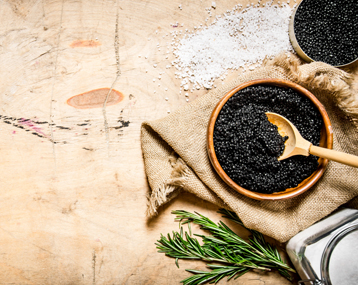


In France, gastronomic luxury reaches its acme in the Gironde region. Its rarest product: caviar. The sturgeons' eggs no longer come from the Caspian Sea and from Russia, where its fishing is banned. The origins of this caviar are diverse: the United States, Italy, Finland, Bulgaria, China and (of course) France where, throughout the 20th century, sturgeons have been farmed.
Aquitaine: homeland of caviar.
Initially, sturgeons were fished for their flesh, not their eggs.Legend has it that a Russian princess, passing through the region, had been offended by seeing fishermen throwing away the eggs without thought … And caviar production began in France.
So, from 1920, on the right bank of the River Gironde, caviar production reached nearly 5 tonnes per year.
Over-fishing and pollution had serious repercussions for caviar production. The sturgeon, fished irresponsibly, began disappearing as a species from French waters. In 1982, sturgeon-fishing was prohibited.
In parallel the Bordeaux Centre for Agricultural Mechanisation and Rural, Water and Forest Engineering launched a programme to restock the area with sturgeons.To set about farming and reproducing specimens of the Siberian sturgeon, Acipenser baerii, the input of expert fish breeders was essential. Aquafarming developed from then and so today in the Bordeaux region of France some 24-25 tonnes are produced.How caviar is produced in Aquitaine.
You have to wait 6 or 7 years to produce caviar. Once the female is sufficiently mature, the eggs can be extracted from the sturgeon's belly: the caviar represents some 15 - 18% of the fish's body.
The eggs are sifted, then washed and drained. Their careful selection in accordance with firmness, size and colour is an essential step. Then the black pearls are salted before being dried and packaged.Non-marine salt is a natural preservative, which allows for the exquisite tastes to be revealed. Salting is a delicate process which can, if there's a mistake, alter the grain completely. It is expert handiwork which cannot be mechanised.What makes Gironde caviar so special is its preparation. Unlike Russian caviar, prepared in brine, Gironde caviar uses dehydrated salt. This gives it a gently iodised taste with a subtlety which explodes in the mouth.Its excellence is appreciated by those with the finest palates who can recognise its gastronomic quality and appreciate its delicate flavours.
Some numbers:
- 80% of French production is carried out in the Gironde region.
- France produces 25 tonnes of caviar per year, of which 24 are produced in the Gironde.
- 90% of Aquitaine caviar now comes from farmed sturgeons, divided between scores of major production sites in the Gironde region.